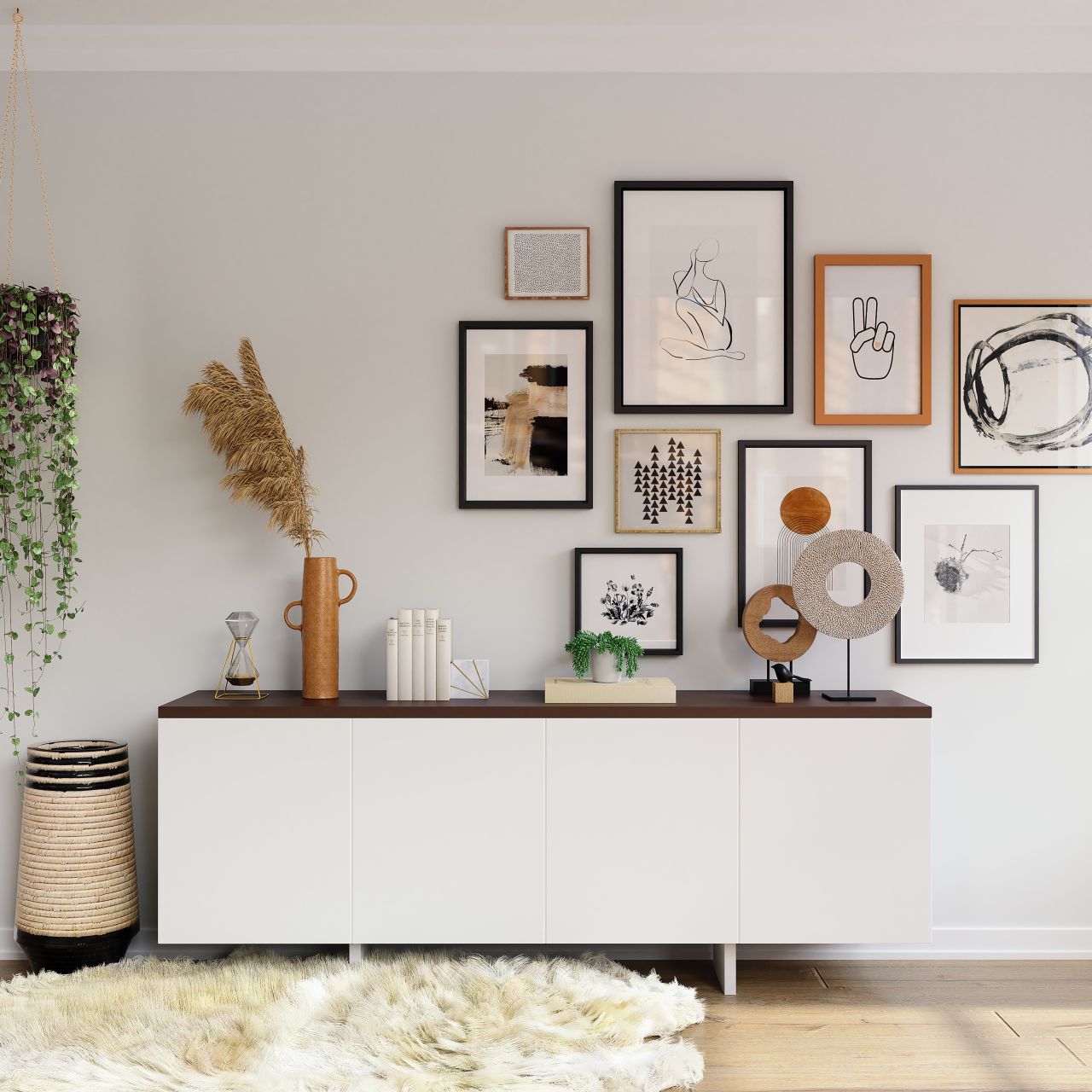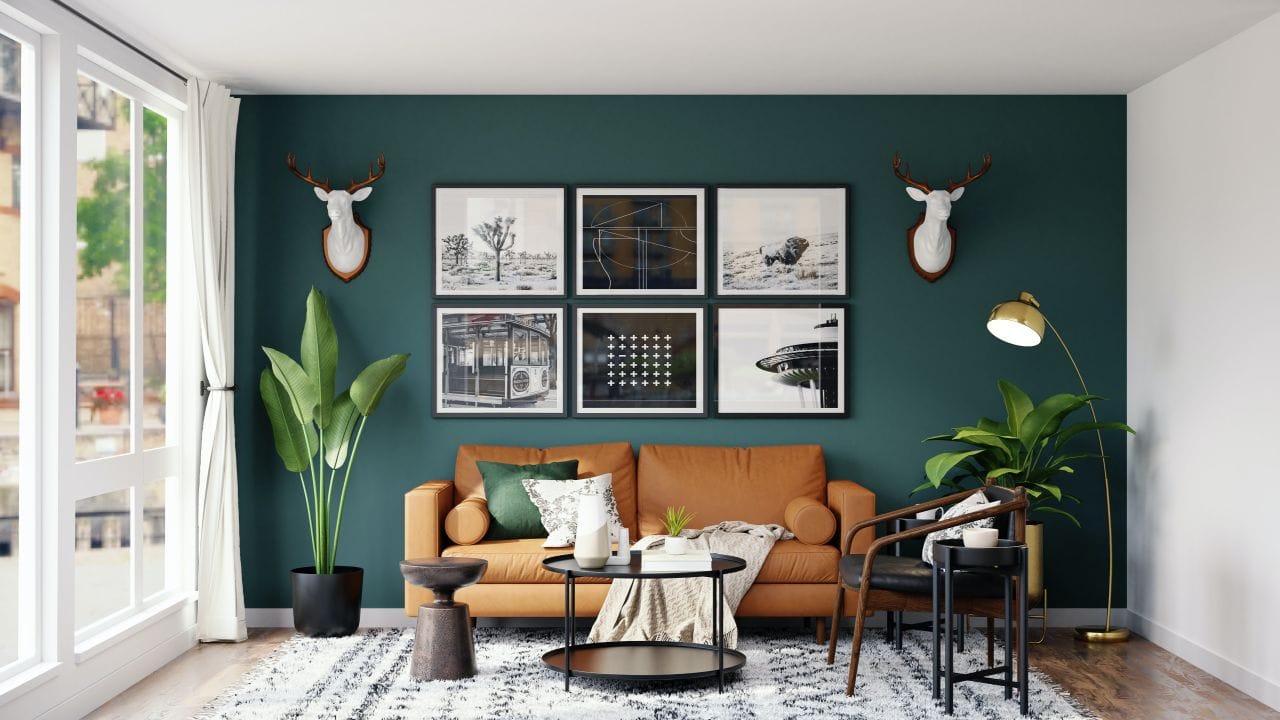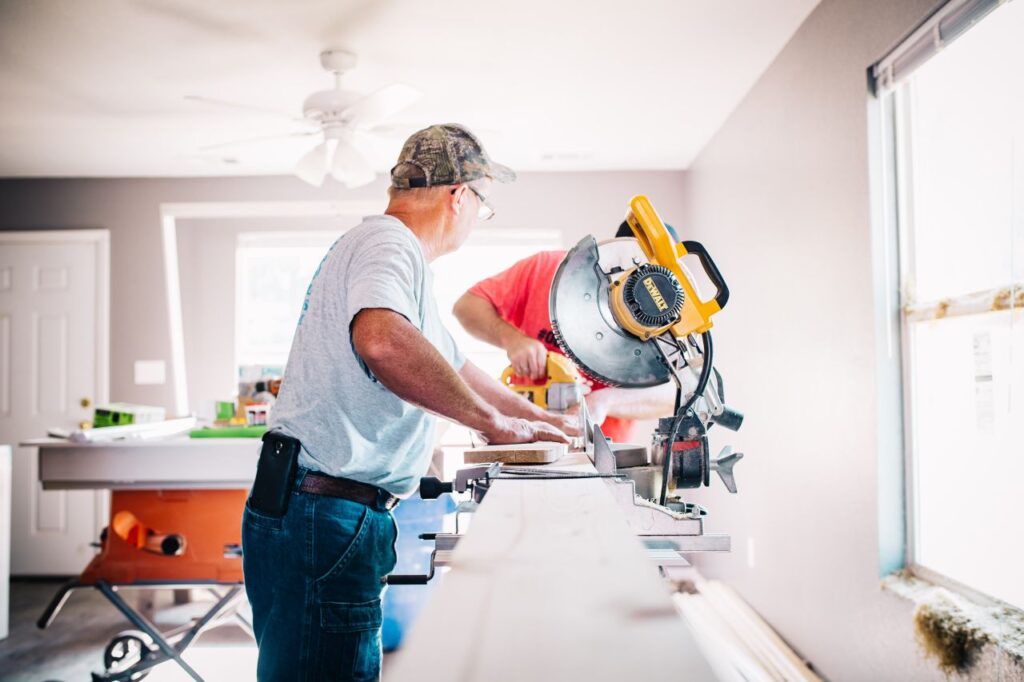Depending on your level of expertise, your financial resources, your personal preferences, and the amount of time you have available, the prospect of beginning a decorating project may be both thrilling and terrifying. If you've never decorated anything before, you can feel overwhelmed by the task.
You may be at a loss for closure if this is all old hat to you. However, you're ready to start fresh and get a new look. The final aspect to pick is a no-brainer, but there are several alternatives for the order of your choices.
You should wait to buy paint until you've decided on the rest of the project's materials because it's cheap and comes in an almost unlimited number of colours. So, where do you start? Do you want to furnish the full space, or just pick out a rug? Do you plan to utilise some fancy wallpaper or a high-end material?
You can literally begin anywhere and piece up a strategy from there. But it helps tremendously if you begin with a strategy, an inspiration item, and a colour palette. Obtain motivation for your decorating endeavour and proceed with it. In the end, you'll be glad you put in the effort to prepare.
You should create a written description for your project like you would for a business plan. The first step in choosing a colour palette is deciding on a design aesthetic that represents you. Are you leaning towards a garden aesthetic, or do you prefer the clean lines of modern design?

Make a pact and keep to it. Not everyone has the luxury of beginning their décor project with a blank slate. You probably aren't ready to get rid of your carpeting, tile floors, or countertops, or other permanent fixtures in your home. Put your energy into the things you care about most. If there are features of your home that you despise but can't change, consider how you may disguise or downplay them in your redesign.
What To Consider When Creating A New Home
- Where can we find out about zoning and construction regulations? Before we can get to the exciting part of the design process—figuring out how to work around the constraints of your great deal, we need to conduct some serious Pre-Design work. We look to see whether there are any environmentally sensitive regions on the site, as well as where on the lot the house can be built and how high it can be, according to the zoning. We can't even begin to describe the complexity of our current project, which is located near a bald eagle's nest (one of numerous types of environmentally significant sites). Being conscious of potential roadblocks early on is crucial. The term "environmentally critical area" (commonly abbreviated "ECA") is used to describe places where protecting the environment is paramount.
- Can you give me an estimate of costs? We have a large database of prior project costs that we regularly update. The ideal construction budget will be established once we and the client have identified various scenarios based on the size and design complexity. Even though it's mostly speculation at this time, it helps provide a baseline for how vast and complicated the house is expected to be.
- Can you tell me whether the client has any specific aesthetic preferences? The client may have a strong preference for either a modern or a traditional design. On other occasions, though, they are ambivalent or open to alternative fashion options. Nothing here makes me rethink the basic plan, but it does get the wheels turning.
- But where is the sun? The location of the house, as well as any shady areas that must be overcome or exploited, will be determined through a solar analysis. Below is an illustration illustrating the sun's path across the property during the year, the direction and velocity of the predominant winds, and the average annual temperature. Even if you aren't trying to build an ultra-green home, it's still worth you to take into account environmental factors like these while planning your floor plan.
- What are the objectives of sustainability? We are currently engaged in the construction of a passive house, another with extensive sustainability objectives, and a third with no such objectives but an open mind. Each one gives me a starting point for thinking about where to put the house, how strong the walls should be (especially on small urban lots, where this might matter a lot), and what roof designs We might consider if we want to incorporate solar panels. To bring sunlight into the inside, shed roofs, for example, are most effective when pitched steeply towards the south. This is problematic because it prevents solar panels from being installed in optimal locations. Therefore, we must make a decision regarding what is most important right away.
- Can you tell me about your next-door neighbours? Can you tell me about the lot's privacy and if there are any nearby houses and their locations? Also, we have a look at the neighbouring houses' architectural styles and have a conversation with the clients about how important it is to be considerate of the people who live nearby. There are many modern houses in Seattle, so this is getting less of a concern. Nonetheless, we should still talk about ways to make this house fit in with the neighbourhood, OR to differentiate it out in some way.
- What are the objectives for this project? This is a little-known fact at the moment. Any architect We know would tell you that they have a never-ending supply of ideas floating around in their brain. It's just a matter of finding the suitable environment and undertaking to test them out on. We can't make a site conform to their ideas, but it's thrilling when We stumble onto one that seems tailor-made for a certain website.
Once we have all of this information, we will begin the design process. To begin evaluating the site's "rules," we first have a meeting with the team to go over all of the above parameters. The aforementioned criteria can often be used to quickly establish the optimal location for a home on a piece of property.
After gathering this information, we retreat to the office where we begin doodling, daydreaming, modifying, and ultimately discarding potential solutions. There is no way to estimate the duration because it is a natural process. An idea will strike me at any time, but other times we have to sift through a plethora of mediocre ones before We find the gems. It's entertaining, challenging, and totally unique.
5 Tips For Decorating A Whole House
Home decorating is a rewarding experience, but it also comes with its share of challenges. How can you keep your unique sense of style without having your clothes look like you threw them together? It may seem challenging to have each space flow into the next, but with these tips, you can create the home of your dreams. And don't worry, we'll show you how to achieve a consistent aesthetic throughout your home without forcing every space to look the same.
1. Choose A Theme
Having a consistent aesthetic across your home is a simple approach to achieve cohesion in the design. Would you classify it as contemporary or classic? Natural or mechanical? Is your favourite design style one that incorporates elements of nature? Do you have any retro jewellery or accessories? the rustic, homey feel of a farmhouse? Do you have anything nautical? With soft sea glass, ocean blues, and a rusted anchor on the mantel, this space evokes a nautical vibe without being over the top. Decide on a style that speaks to you and incorporate it into other areas of your home.
2. Match Materials
Think about the durability and sustainability of the furniture and accents you purchase. The rooms will feel more cohesive if you use the same wicker, wood, or glass of the house. Use a range of textures and finishes to create a natural look rather than one that seems too perfect or forced. In their bedrooms, the homeowners made use of weaved baskets as extra storage space. Storage baskets are a convenient addition to any home, and you can bring the woven texture into other pieces of decor by using furniture pieces or a rattan rug.
3. Choose A Signature Colour.
Which hues most appeal to you? Select a colour that you find aesthetically pleasing and relaxing, and use it as a unifying theme throughout the house. Blend different tones and vary the quantity of colour used in each space. Curtains, bathroom towels, accents, cushions, and the colour of your rugs, art prints are all great ways to add a splash of colour to your home without having to paint the walls. Orange's vibrant undertones liven up a mostly white bedroom, but it may also be utilised subtly in other spaces.
4. Coordinate Wall Colours
Let's discuss barriers now. Choose the same colour scheme across an open floor plan, such as this one, to maximise the sense of unity between the various rooms. Colours that go together on the walls give the illusion that two rooms were designed to be one large one. An easy way to change the colour of a room is to paint it and then close the door.
5. Incorporate Focal Features
Let's circle back around to you, the most vital piece of your abode, after all this discussion of reiteration and harmony. Include a surprise feature or a conversation starter in each space to inject your personality, such as a distinctive framed artwork over your bed or a distinctive lighting in your kitchen. When juxtaposed with a blue backsplash, this crazy red fixture really pops.
Benefits Of Decorating Your Home
It's important to adorn and occasionally redesign your home. If you want to improve your home's appearance and ambience, it doesn't matter if you do it yourself or employ a professional decorator.
If you haven't thought about decorating your home yet, you're missing out on a lot of great things.

It Raises Your Home's Market Value.
If you own a home and have any intention of selling it in the near future, you should take steps to keep it in good condition for potential buyers. A home loses value without proper care and decoration over time. The ideal strategy is to constantly redesign the house so that there is little to do when the time comes to sell.
Improved Hospitality
If you have a lot of friends and family over, you will greatly appreciate this perk. The purpose of interior decoration extends beyond just aesthetics. You go to these lengths also to ensure the convenience of your home for visitors. If you take the time to decorate your home, you may relax knowing that it will look good for guests at any time.
Declutter Your Home
Everyone would have a hard time attempting interior decoration in a messy house. Cleaning and organising your living quarters before beginning any sort of decoration is a must. As clutter accumulates over time, you may reach a point where you simply can't bring yourself to clean it up. But once you make the decision to decorate, you'll muster the energy to sort things out.
Energy Efficiency
One more great thing about the redesign is that it reduces the household's carbon footprint. Energy efficiency is something you can work into your home's design in many different ways. To begin, furnishings are excellent insulators because they provide greater air space between the room's interior and the exterior. Window coverings and carpets can help insulate a home, while rugs and carpets can aid with soundproofing. These purely aesthetic touches can actually help you save money on your energy bills.
Personalization
The unique character of your home can be seen in the details you put into the decor. You have complete freedom to personalise the space anyway you see fit by selecting the ornaments, hues, and layout. As your home or business develops, you get to decide what each area is used for.
Motivation
It's hard to imagine, but home decor can actually boost your productivity. Some people may claim that interior design is a leisure activity for them. The reason behind this is that they find inspiration and pleasure in the act of decorating. If you decorate on a regular basis, you'll get better at it, and it'll start to feel more like a pleasure than a chore.
Improved Mood
It's remarkable how much of an impact home design has on its inhabitants. People's moods are negatively affected by a poorly designed room, whereas those are positively affected by the correct decorations. The more inviting your home is after you've finished decorating, the more time you and your loved ones will want to spend there.
Functionality
Decor may enhance the practicality of indoor and outdoor areas. Decorating your home can make it more lovely, but it can also help you keep it more organised. You can't just start decorating a messy room; first you'll need to clean it up. Decorating a space that you've been struggling to put to use may help you finally do so. If you do this, it will be more prepared to fulfil your needs.
Decorations Can Hide Design Flaws
Problems with the house's blueprint or building process are rather prevalent. If these problems are irreparable or too costly to fix, you can always hide them with some ornamentation. It's possible, for instance, that a break on the surface isn't doing any real damage to the structure. You probably still don't want the crack to be a visual reminder of your building's age. You may hide imperfections like cracks with just a coat of paint or a new wallpaper border.
The Use Of Decorations To Repurpose A Space
There may come a moment when you need to repurpose a space in your home. These spaces can be made more functional for a variety of reasons with the help of appropriate decor. When your kids grow up, you can put that old nursery to good use in another way. The area was transformed into a baby-friendly zone with the help of some creative embellishments, but it could easily be repurposed for various purposes using the same approach.
FAQs About Home Decor
An effective strategy for interior decoration is outlined. For this purpose, you can use a conventional notebook or a specialised unlined sketchbook. Paste in paint and fabric samples or colours that you're drawn to; fill with pictures of spaces, furniture, artwork, and accessories that inspire you; and write down any other ideas that come to mind.
To get started, though, you need to be able to imagine what the whole space or room would look like. So prepare an outline of your decor first. Having a well-thought-out plan is crucial for any decorating endeavour's success.
That's because decorating a room completely from scratch is intimidating! You have nowhere to start and yet so many choices to make. So we pulled together some easy jumping points so you can start decorating your room from scratch.
Finding your design style is the first step. Viewing images of lounge areas can assist in this regard. With this information at your disposal, you'll be able to make more informed judgments about things like flooring, window treatments, wall colour, and more.
Surprisingly, you can determine your decorating style by looking at your wardrobe. When you browse your wardrobe, look at your clothes' colours, patterns, and designs. If you do so, it will indicate your preference and personality.

